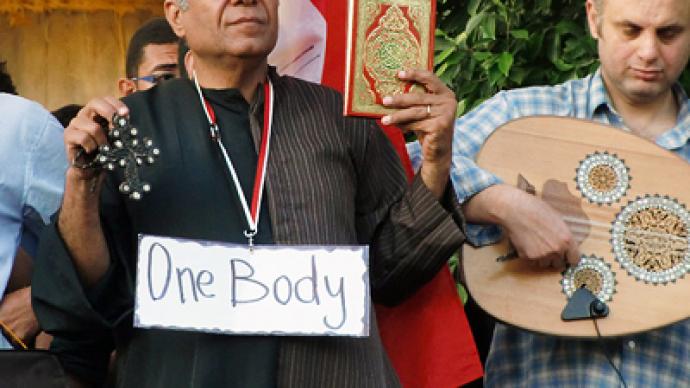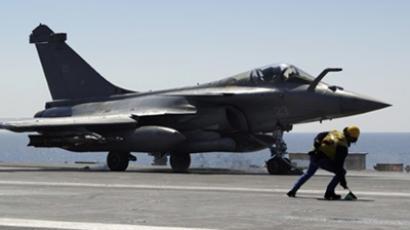Muslims and Christians fraternizing on Tahrir Square

On Friday, May 13, Cairo saw three mass demonstrations instead of one march to break the blockade of Gaza.
On Tahrir Square, Copts and Muslims demonstrated their unity and solidarity with the Palestinian Authority from 10am until late in the night. Near the Israeli embassy, people were demanding that the Israeli flag be lowered and the embassy itself be closed down. Some Copts are still picketing the TV center, demanding thorough investigation into the events of May 7. On that day, a common family fight occurred in Giza, which Western media blew up into a "clash of civilizations".All three demonstrations were the result of the revolution in Egypt, the overthrowing of Mubarak's regime and the ongoing efforts to "steal" the fruits of that revolution. The May 13 march intended to break the blockade of Gaza has been postponed. Not on May 7, nor on May 13 was Egypt's blockade of Gaza lifted, as has been discussed since January 25. I came to Cairo the day before Friday's demonstration. Nothing in the city reminded me of the revolution. I couldn’t see any tanks or police or army troops. There was not a single armed soldier or officer on the streets. Only the US embassy was being guarded heavily, as always. The lawns and pavements on Tahrir Square looked impeccable, although in February, I saw them with my own eyes being taken apart, rock by rock, by protesters who were throwing them at their opponents. The underground system works as usual, and revolution slogans have been carefully removed from all its entrances and exits. Only the scorched headquarters of Mubarak's party look the same. One can't take photos of it anymore: guards wag their fingers from behind the fence as crowds of protesters tell me that it's because the Egyptians don’t want guests of Cairo to take home such ugly images.A million-strong march to break the blockade was supposed to take place on May 13. That plan was conceived on Tahrir Square during the revolution and was timed to coincide with the day of Nakba ('Disaster'), the day of mass exile of Palestinians from their homes that followed after the proclamation of Israel in 1948.
At 10am, the square already began to fill with people. Vehicle traffic was stopped. People on the square were peddling flags of the Palestinian Authority and Egypt, tea, other drinks, T-shirts, and badges. One such peddler gladly poses for me against a background of flags and then tries to sell me a heap of fake papyruses. The guy is obviously having a hard time because of the revolution. He used to work at a resort and then decided to open a store in Cairo – and then the revolution broke out. So he's facing quite a dilemma – to be with the people or to think about personal profit. Those who chose the revolution are aplenty on the square.Street painters paint the colors of the national flag on kids' cheeks. Huge sheets of fabric are laid out on the ground and kids and grown-ups alike are busy painting them with flags and symbols of solidarity with the Palestinian Authority. Hundreds of photos of bomb-torn children in Gaza line the perimeter of the main flowerbed on Tahrir.People keep coming, carrying crosses and Korans. A special stand for the Copts rests in the shadow of posters proclaiming unity and indivisibility of Christian and Muslim communities. Christian speakers are calling for peace with fervor which matches that of Muslim preachers calling for the same. Indeed, it takes seeing it just one time to forget forever the illusion that Christians and Muslims in the East are two different civilizations. They all pray in the common Arabic language.White effigies stuffed with paper are dangling on ropes, with blue hexagrams painted on their chests. Every once in a while people start burning Israeli flags and these effigies with happy excitement. Western reporters shoot these scenes especially zealously.At about midday, we’re informed that the march to Gaza is impossible. On their way to the road to Gaza, young people found themselves blocked at the bridge across the Suez Canal. According to eyewitnesses, the army doesn’t let anyone on the Sinai Peninsula. In the many-thousand-strong crowd I met a well-known young Palestinian film director Hamza Elbuhaisi. He said that he had left Gaza the other day, and that the blockade was in full operation there, and that I would still need all kinds of paperwork and permissions in order to get there. Hamza himself crossed the Gaza border relatively easily for a Palestinian – several hours of exhausting checkups, even though he has his invitations on him. He is now traveling to receive a journalism award, that’s why he was allowed to leave.He’s surprised by the large number of Egyptian Army units brought to the Sinai Peninsula: “The Egyptian Army has gone against Israel, or it looks like that as the agreement between Egypt and Israel forbids keeping servicemen in Sinai, and sending troops there. But they brought the troops. Authorities say that they won’t break the agreement, and then they break their word immediately. This means they cannot carry on with the blockade. Sooner or later it will be over.”But the changes are happening already. There are many Palestinians on Tahrir Square; under Mubarak’s rule this was impossible. As recently as January, special search forces were convoying Palestinians, including children, as if they were vicious criminals, from Gaza to the airport where they had to wait for their flight in a restricted facility. Sometimes they were kept there for a day or even two like prisoners. A kind enough guard would bring them food in exchange for money; otherwise, guards could mock them, keep them hungry, and even stop them from going to the bathroom. The Western media wasn’t taking about it. In Egypt, everyone knew the way the authorities were treating Palestinians. Hatred for Mubarak became consensual when he supported the blockade over Gaza. The time comes for the Friday salah. People form lines and start praying.Even though it’s Friday, Christian churches also have services. As usual, Protestants inspirationally sing to guitar music, dancing and swaying to the melodies. They’re happy to welcome foreigners here, but they ask what one’s faith is, and get very excited hearing that one’s from Russia. They willingly pose for photos and allow shooting during their service. Unlike many of their fellow believers in the US, Egyptian Protestants consider Muslims their brothers, and they didactically tell me about it in several voices.The Copts happily engage in conversation on the square. At the church entrance, there’s less enthusiasm and willingness to talk. And they use all kinds of excuses to stop one from entering the Copt cathedrals, and refuse to have their pictures taken. “You have to understand, we’re under a lot of pressure now. People came from nowhere wanting to persuade the Egyptians that we’re not the locals! That the Copts are foreigners in Egypt! This is unbelievable! They’re like tourists. They arrive, they change their clothes, and they kick us out from Egypt. They find supporters in Egypt, but few listen to them. Our Muslim neighbors defend us. But people are scared.” Ladies from the Copts community who talk to me approve of the demonstration on Tahrir Square. But they also regret that due to clashes last week, the march to break the blockade over Gaza was cancelled. “For Christians, the blockade over Gaza is shameful. Our young people were also going to join the march. And now, instead of that, we have to prove to the whole world that Egypt’s communities and citizens are not each other’s enemies. They want to turn us against each other, so that people wouldn’t think about injustice against an entire Palestinian nation, but rather that we would sit tight feeling scared.”The building where the Israeli embassy used to sit is surrounded by trucks. The road from downtown leading to this building is blocked causing traffic jams along the way. People demand dismantling the Israeli flag from the rooftop. “Next time we will go in”, people say repeatedly. Here, the spirit of confrontation is stronger than anywhere in Cairo, just like in the days of the uprising on Tahrir Square, even though nobody is throwing stones at anyone.In the late afternoon, Gaza government leader Ismail Haniyeh addresses the protesters with a letter. He asks the Egyptian people to refrain from unnecessary confrontations with the army, and guarantees that the Palestinians will surmount the blockade.
Nadezhda Kevorkova, RT













